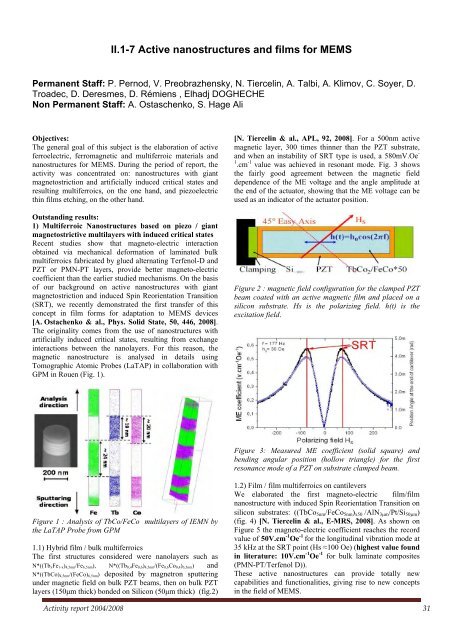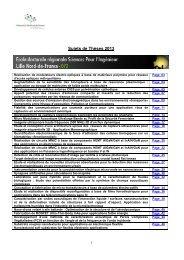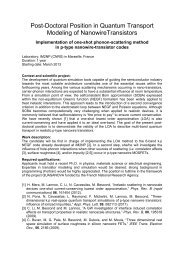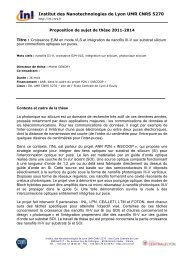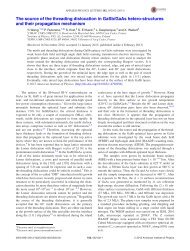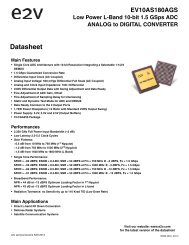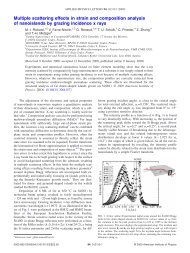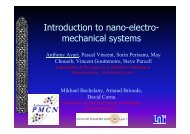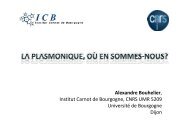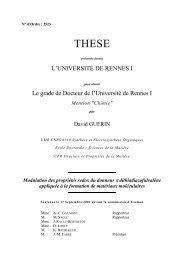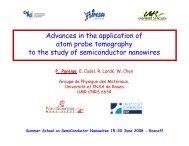Activity Report 2004-2008 (3,5 MB â 1st - IEMN
Activity Report 2004-2008 (3,5 MB â 1st - IEMN
Activity Report 2004-2008 (3,5 MB â 1st - IEMN
- No tags were found...
Create successful ePaper yourself
Turn your PDF publications into a flip-book with our unique Google optimized e-Paper software.
II.1-7 Active nanostructures and films for MEMSPermanent Staff: P. Pernod, V. Preobrazhensky, N. Tiercelin, A. Talbi, A. Klimov, C. Soyer, D.Troadec, D. Deresmes, D. Rémiens , Elhadj DOGHECHENon Permanent Staff: A. Ostaschenko, S. Hage AliObjectives:The general goal of this subject is the elaboration of activeferroelectric, ferromagnetic and multiferroic materials andnanostructures for MEMS. During the period of report, theactivity was concentrated on: nanostructures with giantmagnetostriction and artificially induced critical states andresulting multiferroics, on the one hand, and piezoelectricthin films etching, on the other hand.Outstanding results:1) Multiferroic Nanostructures based on piezo / giantmagnetostrictive multilayers with induced critical statesRecent studies show that magneto-electric interactionobtained via mechanical deformation of laminated bulkmultiferroics fabricated by glued alternating Terfenol-D andPZT or PMN-PT layers, provide better magneto-electriccoefficient than the earlier studied mechanisms. On the basisof our background on active nanostructures with giantmagnetostriction and induced Spin Reorientation Transition(SRT), we recently demonstrated the first transfer of thisconcept in film forms for adaptation to MEMS devices[A. Ostachenko & al., Phys. Solid State, 50, 446, <strong>2008</strong>].The originality comes from the use of nanostructures withartificially induced critical states, resulting from exchangeinteractions between the nanolayers. For this reason, themagnetic nanostructure is analysed in details usingTomographic Atomic Probes (LaTAP) in collaboration withGPM in Rouen (Fig. 1).[N. Tiercelin & al., APL, 92, <strong>2008</strong>]. For a 500nm activemagnetic layer, 300 times thinner than the PZT substrate,and when an instability of SRT type is used, a 580mV.Oe -1 .cm -1 value was achieved in resonant mode. Fig. 3 showsthe fairly good agreement between the magnetic fielddependence of the ME voltage and the angle amplitude atthe end of the actuator, showing that the ME voltage can beused as an indicator of the actuator position.Figure 2 : magnetic field configuration for the clamped PZTbeam coated with an active magnetic film and placed on asilicon substrate. Hs is the polarizing field. h(t) is theexcitation field.Figure 3: Measured ME coefficient (solid square) andbending angular position (hollow triangle) for the firstresonance mode of a PZT on substrate clamped beam.Figure 1 : Analysis of TbCo/FeCo multilayers of <strong>IEMN</strong> bythe LaTAP Probe from GPM1.1) Hybrid film / bulk multiferroicsThe first structures considered were nanolayers such asN*((Tb x Fe 1-x ) 4,5nm /Fe 6,5nm ), N*((Tb 0,4 Fe 0,6 ) 4,5nm /(Fe 0,6 Co 0,4 ) 6,5nm ) andN*((TbCo) 4,5nm /(FeCo) 6,5nm ) deposited by magnetron sputteringunder magnetic field on bulk PZT beams, then on bulk PZTlayers (150μm thick) bonded on Silicon (50μm thick) (fig.2)1.2) Film / film multiferroics on cantileversWe elaborated the first magneto-electric film/filmnanostructure with induced Spin Reorientation Transition onsilicon substrates: ((TbCo 5nm /FeCo 5nm ) x50 /AlN 3μm /Pt/Si 50μm )(fig. 4) [N. Tiercelin & al., E-MRS, <strong>2008</strong>]. As shown onFigure 5 the magneto-electric coefficient reaches the recordvalue of 50V.cm -1 Oe -1 for the longitudinal vibration mode at35 kHz at the SRT point (Hs ≈100 Oe) (highest value foundin literature: 10V.cm -1 Oe -1 for bulk laminate composites(PMN-PT/Terfenol D)).These active nanostructures can provide totally newcapabilities and functionalities, giving rise to new conceptsin the field of MEMS.<strong>Activity</strong> report <strong>2004</strong>/<strong>2008</strong> 31


